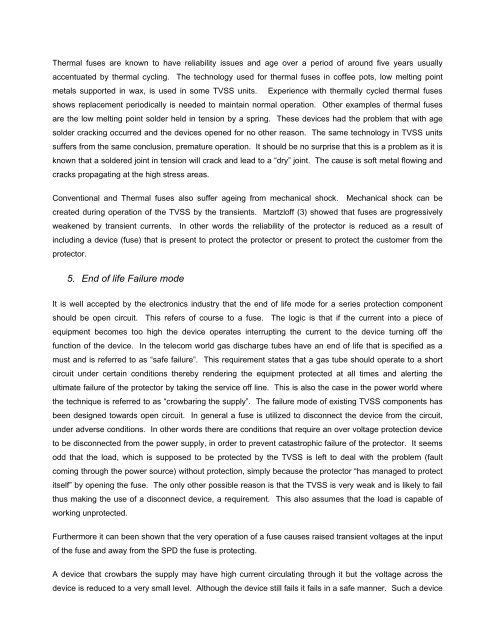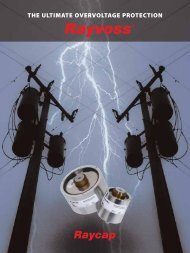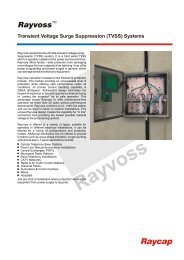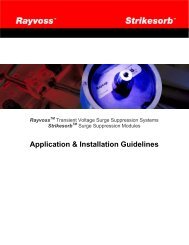3B Strikesorb wp pdf - Limotrique
3B Strikesorb wp pdf - Limotrique
3B Strikesorb wp pdf - Limotrique
You also want an ePaper? Increase the reach of your titles
YUMPU automatically turns print PDFs into web optimized ePapers that Google loves.
Thermal fuses are known to have reliability issues and age over a period of around five years usuallyaccentuated by thermal cycling. The technology used for thermal fuses in coffee pots, low melting pointmetals supported in wax, is used in some TVSS units. Experience with thermally cycled thermal fusesshows replacement periodically is needed to maintain normal operation. Other examples of thermal fusesare the low melting point solder held in tension by a spring. These devices had the problem that with agesolder cracking occurred and the devices opened for no other reason. The same technology in TVSS unitssuffers from the same conclusion, premature operation. It should be no surprise that this is a problem as it isknown that a soldered joint in tension will crack and lead to a “dry” joint. The cause is soft metal flowing andcracks propagating at the high stress areas.Conventional and Thermal fuses also suffer ageing from mechanical shock. Mechanical shock can becreated during operation of the TVSS by the transients. Martzloff (3) showed that fuses are progressivelyweakened by transient currents. In other words the reliability of the protector is reduced as a result ofincluding a device (fuse) that is present to protect the protector or present to protect the customer from theprotector.5. End of life Failure modeIt is well accepted by the electronics industry that the end of life mode for a series protection componentshould be open circuit. This refers of course to a fuse. The logic is that if the current into a piece ofequipment becomes too high the device operates interrupting the current to the device turning off thefunction of the device. In the telecom world gas discharge tubes have an end of life that is specified as amust and is referred to as “safe failure”. This requirement states that a gas tube should operate to a shortcircuit under certain conditions thereby rendering the equipment protected at all times and alerting theultimate failure of the protector by taking the service off line. This is also the case in the power world wherethe technique is referred to as “crowbaring the supply”. The failure mode of existing TVSS components hasbeen designed towards open circuit. In general a fuse is utilized to disconnect the device from the circuit,under adverse conditions. In other words there are conditions that require an over voltage protection deviceto be disconnected from the power supply, in order to prevent catastrophic failure of the protector. It seemsodd that the load, which is supposed to be protected by the TVSS is left to deal with the problem (faultcoming through the power source) without protection, simply because the protector “has managed to protectitself” by opening the fuse. The only other possible reason is that the TVSS is very weak and is likely to failthus making the use of a disconnect device, a requirement. This also assumes that the load is capable ofworking unprotected.Furthermore it can been shown that the very operation of a fuse causes raised transient voltages at the inputof the fuse and away from the SPD the fuse is protecting.A device that crowbars the supply may have high current circulating through it but the voltage across thedevice is reduced to a very small level. Although the device still fails it fails in a safe manner. Such a device






